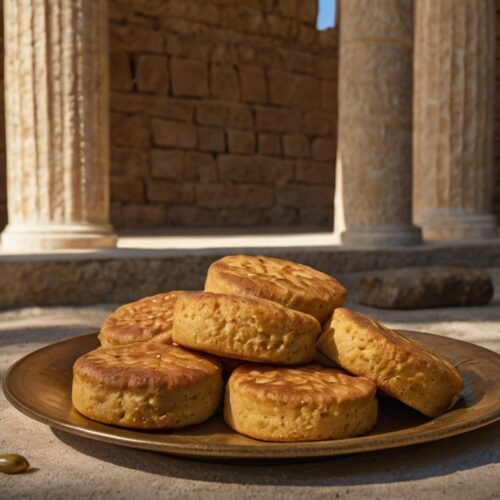The ancient Greeks left behind a legacy of philosophy, art, and politics, but their culinary practices also tell a fascinating story. Among the most iconic foods of the era is maza, a simple barley-based dish that served as a staple for Greek soldiers, farmers, and philosophers alike.
Practical, nutritious, and deeply rooted in the culture, maza offers a window into the everyday lives of the Greeks. Its role during the Greco-Persian Wars, particularly at the legendary Battle of Thermopylae, underscores its importance as a soldier’s sustenance.
By recreating maza and pairing it with a delightful cheese spread inspired by ancient Greek flavors, we can connect to the past in a tangible and delicious way.
If you’re enjoying my content, check out the Eats History Shop for e-cookbooks and merch!
Maza in Ancient Texts
Maza is frequently mentioned in classical Greek literature, reflecting its ubiquity in the diet of ancient Greeks. In Athenaeus’ Deipnosophistae, a 3rd-century CE text detailing the culinary customs of the ancient world, maza is described as a barley-based food that could be prepared in various forms—cakes, porridge, or raw dough.
Hesiod, in his Works and Days, emphasizes barley (krithē) as a vital grain, highlighting its role in sustaining the Greek population. Even the comedic playwright Aristophanes mentions maza in his plays, often humorously pointing to its status as a common yet essential food.
Barley was a cornerstone of the Greek diet, valued for its resilience in the Mediterranean climate and its nutritional properties. The process of grinding barley into flour and mixing it with water or olive oil created a simple, versatile food that could be eaten plain or enhanced with other ingredients like honey, herbs, or cheese.
The Greco-Persian Wars and Thermopylae
During the Greco-Persian Wars (499–449 BCE), Greece faced the might of the Persian Empire, a conflict that would shape the trajectory of Western civilization.
One of the most iconic moments of these wars was the Battle of Thermopylae in 480 BCE. King Leonidas of Sparta led 300 Spartan warriors, along with a small coalition of Greek forces, in a heroic stand against Xerxes I’s vast Persian army.
The narrow pass of Thermopylae allowed the vastly outnumbered Greeks to hold off the Persians for three days, inflicting heavy casualties and showcasing their legendary discipline and courage.
Although the battle ended in the Greeks’ defeat, it became a rallying cry for unity and resistance, leading to eventual victories at Salamis and Plataea.
Maza: Sustaining Spartan Soldiers
Spartan warriors were renowned for their austere lifestyle, and their diet reflected their focus on function over indulgence. Maza would have been a staple in their rations, providing the energy and nutrition needed for intense physical exertion.
Its simplicity made it ideal for military campaigns: barley flour could be carried in sacks, mixed with water or olive oil on the spot, and cooked quickly over a fire. This no-frills meal aligned perfectly with Spartan values of discipline and piety.
At Thermopylae, where resources were scarce, maza likely played a role in keeping the warriors sustained. The dish’s connection to ancient Greek religious practices also added a layer of significance—food was often seen as a gift from the gods, and consuming simple, nourishing meals like maza could be considered an act of piety.
Recreating Maza and a Cheese Spread
Recreating maza at home is a simple and rewarding way to connect with history. Below is a straightforward recipe for maza, paired with a modern adaptation of an ancient Greek cheese spread that incorporates honey, dates, and walnuts.

Maza (Ancient Greek Barley Cakes)
Ingredients
Maza Cakes:
- 1 cup barley flour
- 1 tablespoon olive oil
- 1 teaspoon salt
- Water enough to form a dough
Cheese Spread with Honey, Dates, and Walnuts:
- 1 cup ricotta cheese
- 2 tablespoons honey
- 2 dates finely chopped
- 2 tablespoons walnuts crushed (for topping)
Instructions
Maza Instructions:
- In a bowl, mix barley flour and salt.
- Add the flour to a pan over medium heat
- Toast the flour and add the olive oil
- Add water and form dough cakes
- Cook the cakes for 2–3 minutes on each side, until firm and slightly browned.
Cheese Spread Instructions:
- In a bowl, mix ricotta cheese and honey until smooth.
- Stir in the chopped dates.
- Serve the cheese spread alongside the maza cakes, topped with crushed walnuts for added texture and flavor.
Video
Notes
- Barley Flour Texture: Barley flour is coarser than modern wheat flour, giving the maza cakes a rustic texture. Toasting the flour lightly before use enhances the nutty flavor.
- Cheese Spread Variations: Substitute ricotta with goat cheese or Greek yogurt for a tangier option, keeping the dish closer to Mediterranean roots.
- Adjustable Sweetness: Add more or less honey in the cheese spread to suit your preference, or drizzle additional honey on top for presentation.